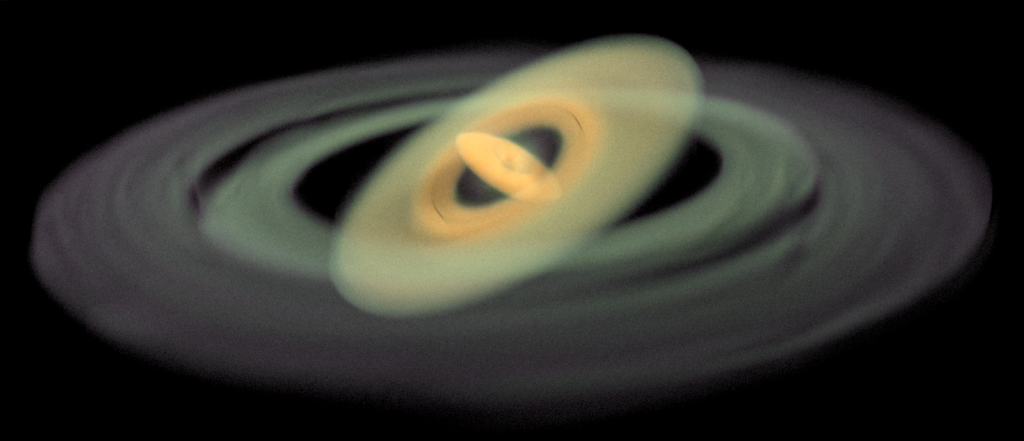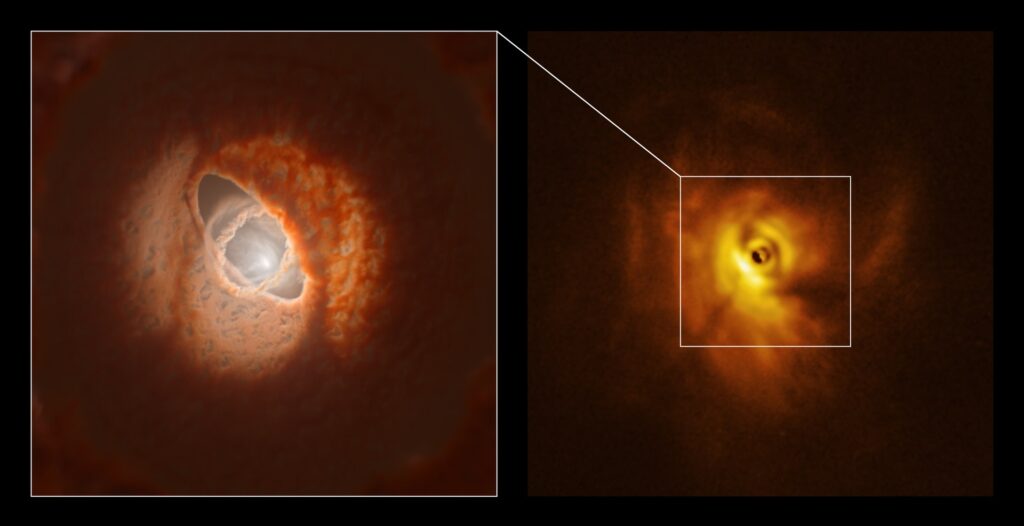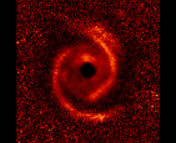Title: Warps and Breaks in Circumbinary Discs
Authors: Ian Rabago, Zhaohuan Zhu, Stephen Lubow, Rebecca G. Martin
First Author’s Institution: Department of Physics and Astronomy & Nevada Center for Astrophysics, University of Nevada, Las Vegas
Status: Submitted to MNRAS [open access]
Space: the final frontier. It would sure be nice to use the warp drive to reach distant galaxies, stars, and planets in no time at all. It is very unlikely that something like this will exist in the near future. Luckily, there are other warped things in the Universe, and they are quite exciting themselves!
Let’s fly with Warp 5 to explore warped disks
Gradually, the existence of warped astrophysical disks becomes more and more evident. Such disks are not situated in one plane like a normal disk, but are tilted within themselves: a part of the disk is inclined with respect to another part. Figure 1 shows an example of a warped disk.

Warps can occur in all kinds of astrophysical disks – from galaxies to disks around black holes and protoplanetary disks. The physics of how and why a warp occurs can be quite different depending on the disk type, which is why we focus on accretion disks in this article. Accretion disks are a collection of gas and dust around a massive central object.
While we’re flying, let’s have a look at our warp drive
Warps in accretion disks can have many different causes, discussing all of them would fill pages. Instead, let us focus on one: a binary system inclined with respect to the plane of the disk. We specifically look at circumbinary disks enclosing both binary components. In such a configuration, a disk will warp due to the gravitational pull of the binary onto the disk. The binary’s gravitational potential leads to a precession of the disk, with the inner disk part (closer to the binary) affected more by the gravity, thus precessing faster. Because different parts of the disk precess at different rates, a warp arises.
Now, we need to know that an accretion disk is connected due to internal disk physics. This means that the disk has a way to communicate its precession rate through the disk to the outer part. This communication takes a certain amount of time, which highly depends on the disk properties, i.e., on the disk’s vertical extent (=thickness) and its internal turbulence (=viscosity). In thin disks with high viscosity, the communication time is short compared to the precession time. In such disks, the fast precession at the inner part of the disk can be communicated efficiently to the outer disk part. This leads to a continuous, yet warped disk. In an extreme case, the precession is communicated so fast that the warp doesn’t even form, the entire disk remains planar and precesses like a solid body. However, if the communication takes much longer than the precession, the inner disk part changes quickly before the outer part even notices. In this scenario, the disk might tear apart into a so-called broken disk, pictured in Figure 2.

Did we break our warp engine?
Broken disks are observed frequently in the Universe. Therefore, it is important to understand their formation, evolution, and appearance in observations. One of the main observational signatures is a shaded region or shadow lanes cast from the inclined inner part onto the outer part of the disk. Their exact appearance depends on the location of the break.
In today’s paper, the authors aim to develop an improved model to easily predict if and where a disk breaks based on disk properties. Comparing the precession and communication times, they derive an analytical expression, which depends on disk properties such as thickness, viscosity, and disk size, and on the binary parameters such as mass distribution, orbital parameters, and respective orientation between disk and the binary orbital plane. Next to the disk viscosity, one of the most influential parameters on whether a disk breaks is the proximity of the disk’s inner edge to the binary system: the further in the disk edge, the more likely it is to break.
In order to test their analytical formulation, the authors perform four three-dimensional simulations varying the disk viscosity. Their binary system is inclined by 60° with respect to the initial plane of the disk. In Figure 3, you can see that the disk breaks for low viscosity, as a small inner part of the (red) disk is separated from the outer part. At high viscosity, the disk does not break, as the communication time is shorter than the precession. Comparing the location of the break from the three-dimensional simulation to the one calculated in their analytic model, the authors find excellent agreement.

Reaching our destination: GW Orionis
GW Orionis is a triple system with a protoplanetary disk enclosing all three stars. Observations (see Figure 4) reveal that the disk is broken. This system was modeled in previous studies in order to investigate the origin of the break. However, the results of different studies vary vastly: some indeed find a disk break, while others find no break at all. The latter case would mean that the observed break must have another explanation than the inclined triple star system.

Why do different studies result in different outcomes? The answer lies in the disk and triple system properties. Because it is very hard to extract those from the observations, the different research groups assumed slightly different properties. The authors of today’s paper apply their analytic model to those studies. For this, they approximate the triple system as a binary in order to simplify the calculations. With this, they are able to explain the differences: because the breaking of a disk is so sensitive to the properties, the slight variations in initial conditions between the groups lead to the differing results.
Back to home – hopefully the warp engine doesn’t break again
Exploring their analytical model, the authors of today’s paper find possible scenarios in which a disk can break multiple times. Here, they find that thin disks with inner edges very close to the binary and steep density and temperature profiles are more likely to do so.
The authors choose a scenario with three predicted breaks and perform a full 3D simulation, which can be watched in this video. The disk indeed breaks multiple times. However, not all of the locations coincide with the analytically predicted model. This shows that it is still challenging to predict the exact locations of the breaks, especially when they are close together. Of course, analytical models have to take assumptions as their purpose is to simplify the description of complex processes. In future work, one can attempt to improve those assumptions in order to predict the break locations more precisely. For now, the analytical model presented in today’s paper is a great step forward to boldly go where no one has gone before.
Astrobite edited by Isabella Trierweiler
Featured image credit: Lina Kimmig




